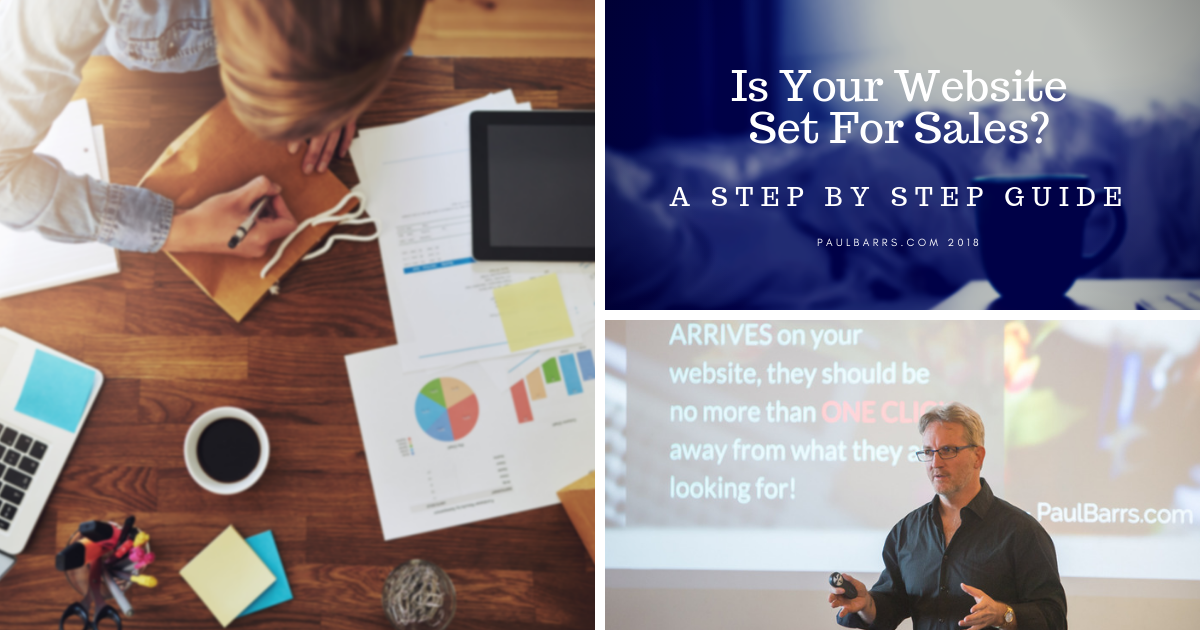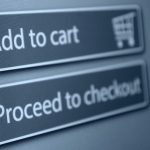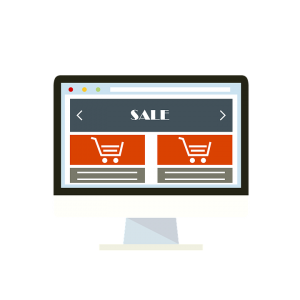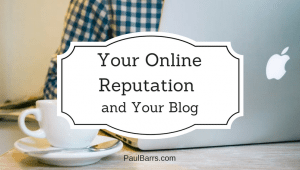
04 Dec Set For Sales
Set For Sales – Is Your Website ready?
Quick question… Are you happy with your website’s performance? Chances are if you’re like any of the hundreds of small business owners I talk with each year, you can’t answer with an unequivocal “Yes!”.
You’re more likely to say ‘somewhat happy’, or ‘sometimes happy’, but not “absolutely happy!”
So what can we do about it? What can YOU do about it? I suggest you sit down and go through the following “Set for Sales Checklist.” It’s my simple step by step guide to helping you get the best from your website so that it performs – no – OUT-performs your expectations and starts bringing in new leads, sales and revenue on a regular basis.
Got your pen and paper handy? Let’s get started 🙂
Sidebar: Though it might seem obvious to some, it’s not to most.. this is a “checklist”. That means you need to CHECK on which things you’ve done and which things you haven’t. From there you create an action plan, and you plan to take action on those unchecked items.
There’s the difference between success and failure right there. Doing and not doing. Getting stuff done… or not.
 The Point of Sale
The Point of Sale
The first thing to check on any website is that point of “sale” or Contact if you’re after leads and not direct sales.
Check that your –
- Checkout is working
- Contact forms are working
- That you’re using Google Analytics to track the conversion point.
- That you have AT MINIMUM one automated reply email following contact or sale.
- Note: Best to have at least 2, explaining how the customer’s email / order has been receive and how they should expect to hear back from you / have their order fulfilled.
- Also check that if they hit ‘reply’, that their email is received by a real person.
- If you’re using a shopping cart, that you have an automated follow-up for abandoned cart items. This is a beauty. Want to see it in action, go to SleepandSound.com.au and walk your way through the checkout process.
These things are the ultimate. It doesn’t matter how much traffic you’re getting, if you fail your customer during that final point of sale or point of contact, you may as well shut up shop today and go sit on a beach somewhere.
 The Home Page
The Home Page
The homepage is usually the most visited page on your site. More often than not, it’s the first thing a potential new customer will see. I call it the Front Door to Your Store.
Check that it does the following –
- Showcases what you offer in a 2-second snapshot above-the-fold!
- “Above the fold” refers to that section of the page that the user sees before they begin to scroll.
- If it isn’t 100% CRYSTAL-CLEAR what you offer / do / sell in that small piece of space, in that small window of time, then you need to fix it.
- IMMEDIATELY!
- Has direct links to your main product pages / product categories displayed clearly and obviously.
- Use either an image to ‘explain’ or a short paragraph of text.
- The goal of the homepage is not to convert a customer or sell a product; it’s to get them to where they want to be with the least amount of clicks possible.
- Apply the 80 / 20 rule. If you sell more than half a dozen or so products and services, understand that you’ll never be able to make every visitor happy with what’s showcased in the homepage featured areas. Focus on the main meal. Use additional menus for the crumbs.
- Loads in 3 – 4 seconds!
- This is a tough one. And these with some CMS’s like WordPress, it can seem next to impossible. But Google has made it clear – SPEED is crucial when it comes to conversions.
The Primary Product Pages
Product or ‘service’, it doesn’t matter. Whatever it is that you ‘sell’, you need to have solid content / authority pages that ‘sell’ what you sell.
Again, follow the 80 / 20 rule. Do this for your big sellers. The things that people are searching for. The things that people will have questions about. The things that earn you the lion’s share of your income.
When it comes to these pages, make sure that –
- If the page has a lot of information, that you include a summary at the beginning which makes it clear what the reader what they can expect from the page.
- It should also have internal anchor-links to sections to make it easy to navigate.
- Whatever the length, it should focus on the CORE ELEMENTS of the product / service first. Don’t waffle. People are there for a reason. Show the most obvious benefits first.
REMEMBER: The Main Thing Is to Remember That The Main Thing IS The Main Thing.
- Make sure that there are EASY to FOLLOW links to your products so people can BUY from you!
- Or ‘contact you’ as it may be.
- Use bullet points and summaries. Make it EASY to read. Don’t just spew out pages of boring text.
- Never have a ‘full screen’ of nothing but text (where text is all that can be seen). Use images, graphs, and charts to break it up and make it easier to read.
- People don’t read these types of pages, they scan them to find what they’re looking for.
- Use social proof for EVERY claim that you make.
- Always tell people WHY they should BUY from you.
Product Pages (shopping cart)

- Make sure your images are correctly sized and clear.
- Have more than one image where required (such as colours and options etc.)
- Use the same sized images across your shop for continuity.
- Offer clear pricing options as they apply.
- Offer either a detailed description or a link to ‘more information’ if required.
- If the product is technical, offer a PDF download of the full fact sheet.
- Consider offering the PDF download behind a subscription-gate so you can capture details.
- Always have automated email follow up for such subscription.
- The follow ups should be generic enough that when a subscriber buys the product, the follow-ups aren’t still asking them to ‘buy’. Don’t ask them to ‘buy’ talk about when they “own” the product.
- Do you have a video? Any product worth over $100 should have a video. Offer options to watch it on the product page.
- Be sure to test it on mobile.
- Always include ‘cross sale’ opportunities. i.e. ‘people who like this also like….’
- Always offer ‘up sell’ opportunities at checkout. i.e. ‘would you like fries with that…?’
Other Pages / Blog Posts
It’s important you look at your analytics to see what your most visited pages are and then make sure of the following –
- That they offer a clear link directly to a ‘product’ or the ‘contact form’
- They should also offer a link to a ‘read more’ page such as your primary product / service authority pages using correct ‘anchor text’ for SEO purposes.
- If these pages don’t add to your bottom line, ditch them!
SEO and Social Meta
All pages, posts, and products should have well written meta-data. This is the section of code that includes the meta-title and meta-description which are often used by search engines to ‘showcase’ your page (the information that appears IN the search results); or in Social Media when a page or post is shared.
At minimum you should have –
- A meta-title which is no more than 65 characters.
- A meta-description which is no more than 155 characters
- Yes, these lengths change in the official notes from time to time; which is why the above guidelines are a good rule to follow.
- A ‘featured image’ that is used in the Social Meta (open graph) tags.
- I use Facebook’s Image Guide as my rule of thumb for sizing.
You should also CHECK how your pages and posts appear in your primary targeted platforms (i.e. Facebook, LinkedIn, Instagram).
It’s also worthwhile looking into more advanced code like Rich Snippets and how to manage your Site Links to help your pages appear more attractive in search results too.
And a Final Note on SEO, External Links (backlinks), Email Marketing and Social Media
While not directly related to the ‘sales’ on your site (or moving people towards your contact form), the following things are essentials for a well rounded business website. After all, getting good rankings and tons of traffic from search engines can be the ‘single thing’ that brings you more customers over any other – but – you need to know what you need to know!
First things first, when it comes to SEO, you need to cover the following basics:
- Make sure your site is technically sound.
- Make sure your content is highly relevant.
- Make sure you add new content on a regular basis
- Create a strong internal link profile across your site and main pages.
- Create a strong external link profile to both your homepage and your main pages.
Sidebar: Having a strong backlink profile can contribute enormously to your rankings in search engines. Strong however doesn’t mean just ‘numbers’. It means building quality links from authority sites and removing crappy link from low quality sites. You should –
- Do a backlink audit and take necessary actions to disavow spammy links.
- Schedule regular revisions at least quarterly.
- Work consistently to build new links through quality content and link outreach.
If you don’t do these things, you could literally be ‘shooting yourself in the foot’ as Google may be penalising your for things that could have been simply and easily managed.

Social Media will drive you bat-shit bananas if you let it. REMEMBER: It’s not the silver bullet, it’s just one part of the overall internet business puzzle.
Email Marketing and Social Media
You’ve probably heard it before, people tend to buy from those who they know, like, and trust!
Here’s the thing. They may not know you, but they’ve sure got to feel like they like you and trust you. But when it come to online and all things digital, people can feel like they know you.
And that’s what counts.
Therefore you MUST keep in touch with people via email and social media.
- Make sure that you have access to a full service email automation system.
- Use that system to send out regular EDM’s (electronic direct mail).
- You should use both a ‘newsletter’ and automated follow up emails.
- Segment your lists as much as possible and then customise your messages to each segment.
Then, with social media –
- Create custom audiences from your email lists so that they see customised ‘ads’ to bring them back to your site.
- Create custom audiences from people who have visited your site already, to bring them back with new offers, specials, and events.
- I recommend that each time you publish a new blog post, that you use re-marketing to grab visitors who’ve already visited your site come back and read the new article.
- You can do similar with Google Ads to capture past traffic and bring them back also.
Wrapping Up
So, now what?
Did you take notes? Did you find a few things where your site is lacking and could do with some action? Good. Then go do it!
Or…
If you’re not sure how (how to actually DO those things), then just ask me. Give me a call, or submit a contact request. If you’re local, I’d be more than happy to catch up for a coffee and go over some notes.
You’ve got everything to gain, and nothing to lose.
Warm Regards,
Paul Barrs.

Digital Marketing for Small Businesses Online

 The Point of Sale
The Point of Sale The Home Page
The Home Page


